Table of Contents
Whether you are looking for exercises to diversify your training routine in the gym, or you need new inspiration for home training, you’ve come to the right place. In the article, you will find effective bodyweight exercises, their correct technique, different variations, and tips to make them more difficult for more experienced athletes. See for yourself that it is possible to have a great workout and at the same time keep yourself fit or support weight loss or muscle growth even without equipment. Try to revive your training routine, for example, by full body bodyweight workout or HIIT.
What benefits do bodyweight exercises offer?
First of all, you don’t need any special equipment. An exercise mat should be enough. Moreover, there are many more benefits of bodyweight workout.
- You can exercise anywhere. Even in your living room, hotel room, garden, park or street workout spot.
- Bodyweight exercise are also great to diversify your gym workout.
- You can tailor the exercises to suit your fitness level and ability.
- Your body will face a new type of load, which can lead to muscle and strength growth.
- You can use bodyweight exercises to create a circuit, interval or classic training with a fixed number of sets and reps.
- You will strengthen your core which is essential for good posture.
- If you work out at higher intensity, you will improve your physical fitness.
- If you maintain the correct technique, you will develop coordination and flexibility.
- Plyometric exercises will enhance your agility.
- You will burn a whole lot of calories and thus reinforce weight loss.
- Such a workout will take you up to 30 minutes, which will be appreciated by busy managers, moms on maternity leave, and others who are always running out of time. [1–4]
Want to start exercising and eating healthily? Then you may be surprised by all the benefits of a healthy lifestyle. If you are interested in this topic, read our article How Does Your Body and Mind Change When You Begin Exercising and Eating Healthily?
Is it your first bodyweight workout? Try these 12 exercises
You can include these 12 exercises in HIIT or circuit training. You can, of course, choose only exercise that fit your training plan. Furthermore, you can also get inspired by our sample workouts below. Don’t forget to engage your core and focus on the correct technique during each exercise. Once you master the basic variation, feel free to try other exercise variations or add some weight. This way, you can make every exercise more demanding.
1. Push-Ups
- Starting position: Kneel and get to the high plank position with arms extended. Place your open palms below your shoulders, closer than the shoulder width. Pull your shoulders away from your ears and your shoulder blades down and back. Elbows should be 45 degrees away from the body. Activate your core and maintain the body in a line. Don’t bend your back, especially in the lumbar spine.
- Execution: Exhale, do a push-up, and try to lightly touch the floor with your chest in the lower position. Then push your palms and fingers into the mat while inhaling and return to the starting position. Do the next rep.
- Common mistakes: A small range of motion, bent back (especially in the lumbar spine), unstable shoulder blades, the elbows point away from the body.
- Exercise variations: Knee push-ups with feet or hands placed in a higher position (bench, sofa, lower pull-up bar), clapping push-ups, headstand push-ups.
- How to make the exercise more challenging by adding some equipment: Slamball push-up, fit ball push-up and balance pad push-up, push-up with a weighted vest, plate on your back, with a suspension trainer, with a push-up bar or an expander around your body attached under your palms.
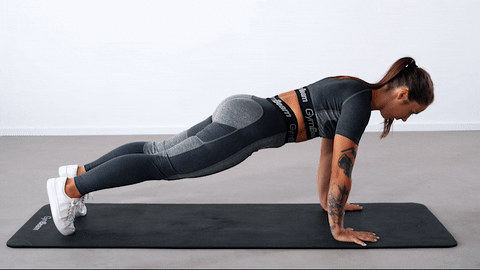
2. Plank
- Starting position: Kneel and get to the high plank position with arms extended. Place your open palms below your shoulders, closer than the shoulder width. Pull your shoulders away from your ears and your shoulder blades down and back. Elbows should be 45 degrees away from the body. Activate your core and maintain the body in a line. Don’t bend your back, especially in the lumbar spine.
- Execution: Breathe naturally, keep your body still, and try to maintain this position for a couple of seconds (measure the time on your sports watch or phone).
- Common mistakes: Bent back, the hips fall to the floor, the pelvis is too high.
- Exercise variations: Knee plank, plank with arm or leg raise, or plank with opposite arm and leg lift.
- How to make the exercise more challenging by using some equipment: Fit ball plank, balance pad plank, slam ball plank or suspension trainer plank.
If you are interested in how regular plank exercise can affect your figure, read our article What Will Happen When If You Do Plank Every Day.

3. Glute Bridge
- Starting position: Lie on your back and place your arms alongside your body with palms facing down. Bend your knees, pull them towards your butt, and leave your feet on the floor.
- Execution: Raise your pelvis by activating your glutes and hamstrings. Concentrate on the contraction of the glutes in the upper position. Hold for a second or two, and then lower your pelvis with a controlled movement. Do the next rep.
- Common mistakes: A small range of motion, an insufficient glute activation, bent back bent, an uncontrolled movement.
- Exercise variations: Isometric hold in the upper position (20–30 seconds), single-leg glute bridge (one leg is extended and aims to the ceiling).
- How to make the exercise more challenging by using some equipment: Balance pad glute bridge, glue bridge with resistance band above the knees or kettlebell on the pelvis.
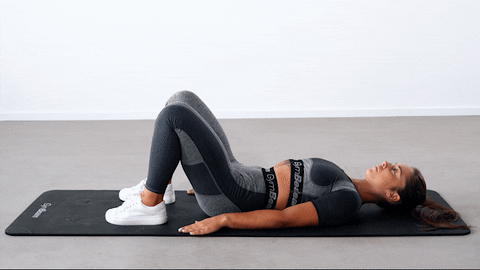
You might be interested in these products:
4. Spider Lunges
- Starting position: Kneel and get to the high plank position with arms extended. Place your open palms below your shoulders, closer than the shoulder width. Pull your shoulders away from your ears and your shoulder blades down and back. Elbows should be 45 degrees away from the body. Activate your core and maintain the body in a line. Don’t bend your back, especially in the lumbar spine.
- Execution: Do the lunge with the right leg while exhaling (ideally up to the right palm, if your mobility and flexibility allow). Then breathe in, and return your leg to the starting position. Then do the lunge with the left leg to the left palm.
- Common mistakes: Bent back.
- Exercise variations: When you do the lunge, raise the same arm as the working leg, and look at the ceiling.
- How to make the exercise more challenging by using some equipment: Place the resistance band above your ankles or use ankle straps.

5. Plank Shoulder Touch
- Starting position: Kneel and get to the high plank position with arms extended. Place your open palms below your shoulders, closer than the shoulder width. Pull your shoulders away from your ears and your shoulder blades down and back. Elbows should be 45 degrees away from the body. Brace your core and maintain the body in a line. Don’t bend your back, especially in the lumbar spine.
- Execution: Raise your right arm and touch the left shoulder. At the same time, try to maintain a stable position. Then return the arm to the mat and do the same movement on the other side.
- Common mistakes: Bent back, an uncontrolled movement, leaning to the sides.
- Exercise variations: Knee plank.
- How to make the exercise more challenging by using some equipment: Fit ball or balance pad plank, or use wrist straps.

6. Squat
- Starting position: Shoulder-width stance. The weight is on the whole foot.
- Execution: Inhale and do the squat by pushing your pelvis back and down. Watch out for the wrong bent in the lumbar and thoracic spine. Go deep to the point where you can maintain the back curved naturally. The axis of the knee, ankle, and feet should be in a line. Go up by activating glutes and front tight muscles while exhaling. Do the next rep.
- Common mistakes: Bent back, a small range of motion, leaning forward, the knees point inwards, the weight is distributed unevenly, shifting too much weight to the toe or heel.
- Exercise variations: Single-leg squat, squat pumps (squatting in a range of a few centimetres in the lower position).
- How to make the exercise more challenging by using some equipment: Squat with resistance band above knees, with the fit ball above the head, on the balance pad, with a barbell, kettlebell, medicine ball or power bag.
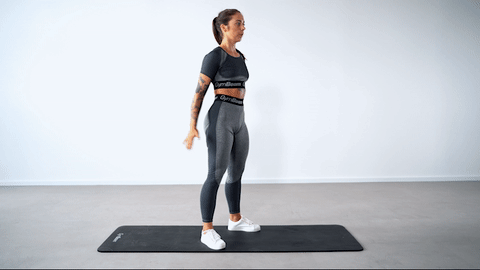
7. Side Lunges
- Starting position: Mid-wide stance.
- Execution: Inhale, do the side lunge with one leg and shift your weight to this leg. Return to the starting position while exhaling, and do the lunge on the other side. The knees and feet point in the same direction during the whole time, slightly to the sides.
- Common mistakes: Bent back, a small range of motion, the knees point inwards.
- Exercise variations: Side lunge jumps.
- How to make the exercise more challenging by using some equipment: Lunges with the expander above the knees or ankles, lunges on the balance pad, with a kettlebell, medicine ball or power bag.

8. Squat Jump
- Starting position: Shoulder-width stance. The weight is on the whole foot.
- Execution: Inhale and do the squat by pushing your pelvis back and down. Watch out for the wrong bent in the lumbar and thoracic spine. Get deep to the point where you can maintain the back curved naturally. The axis of the knee, ankle and foot is in a line. Do the jump by activating the glutes and front tight muscles while exhaling. Inhale in the upper position, then return to the squat and repeat the jump.
- Common mistakes: Bent back, a small range of motion, leaning forward, the knees point inwards, the weight is distributed unevenly, shifting to the toe or heel.
- Exercise variations: Add another jump in the upper position by pulling the knees towards the chest (so-called tuck jump).
- How to make the exercise more challenging with equipment: plyometric box squat jump, balance pad squat jump or with power bag.
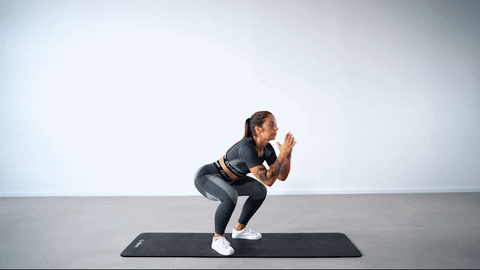
9. Jumping Lunges
- Starting position: Mid-wide stance.
- Execution: The feet and knees point in the same direction during the whole time, slightly to the sides. Start by a step forward and slightly to the side. Shift your weight to the front leg. Get deep to the point where your knee creates 90 degrees with your calf or even lower. Jump by activating the glutes and front tight muscles while exhaling, and change legs. As soon as you land on the floor, inhale and do another rep. Use your arms to help you with stability.
- Common mistakes: A small range of motion, wrong coordination.
- Exercise variations: Front lunges without the jump.
- How to make the exercise more challenging with equipment: Balance pad jumping lunges, jumping lunges with a power bag, axle bar or weighted vest.
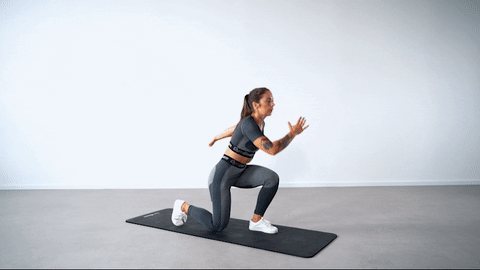
10. Single-Leg Deadlift
- Starting position: Mid-wide stance.
- Execution: The feet and knees point in the same direction during the whole time, slightly to the sides. Shift your weight to the standing leg, which is bent slightly. Lean forward while inhaling and simultaneously extend your other leg backwards stretched. Return to the starting position by activating the glutes and front tight muscles while exhaling. Use your arms to help you with stability. First, do some reps with one leg, then with the other.
- Common mistakes: A small range of motion, wrong coordination, bent back.
- Exercise variations: Use a chair to help you with stability.
- How to make the exercise more challenging with equipment: Single-leg deadlift with the kettlebell in one hand, fit ball above the head, on the balance pad or suspension trainer.

11. Reverse Lunges
- Starting position: Mid-wide stance.
- Performance: The feet and knees point in the same direction during the whole time, slightly to the sides. Do the back lunge with one leg while inhaling. The weight is on the standing leg, and the back leg knee lightly touches the mat. Return to the starting position while exhaling. Then do the lunge to the other side. Use your arms to help you with stability.
- Common mistakes: A small range of motion, wrong coordination, bent back.
- Exercise variations: Reverse lunges with chair, alternating jump lunges, reverse lunge with knee lift.
- How to make the exercise more challenging with equipment: Reverse lunges with an axle bar, power bag, kettlebell, fit ball above the head or on the suspension trainer.

12. Walkout
- Starting position: Mid-wide stance.
- Execution: Lean forward while inhaling and get to the high plank with your arms extended. Brace your core and use your hands to push yourself away from the mat and continuously return to the starting position. Straighten your back and move on to the next rep.
- Common mistakes: Bent back, the hips fall to the floor.
- Exercise variations: Add shoulder touches or raise the limbs in the upper plank position, do a push-up in the lower position.
- How to make the exercise more challenging with equipment: Add a weighted vest.
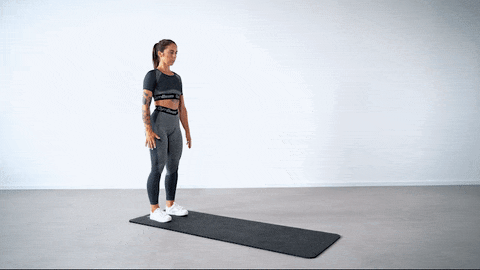
3 sample bodyweight workout
Don’t rack your brain over creating a workout. Pick one of our three sample workouts, grab your mat, and let the hard work begin! Remember to support the regeneration process with a protein drink.
Don’t forget to lightly warm up your body before the main part (running on the spot, jump rope). Then prepare your body for the upcoming exercise by performing circular motions in your large joints. Once you finish the workout, find some time for stretching.
1. Bodyweight HIIT for Better Physical Condition
- 30 seconds work, 30 seconds rest
- start with the exercise 1, then move on to the exercise 2, etc.
- try to execute 3 to 5 sets
- take a 60 to 90 second break between the sets
HIIT Workout Exercises:
- Walkout
- Squat Jumps
- Plank Shoulder Touches
- Spider Lunges
- Lunge Jumps
If you are interested in the benefits of HIIT workouts, read our article Classic Cardio or HIIT Workout – Which One Burns Fat Better?
2. Full-Body Bodyweight Workout
First, execute all sets of one exercise, then proceed to the next one. Add load and choose another exercise variation if needed. Take a 1–2 minute break between sets.
| Exercise | Number of reps | Number of sets |
|---|---|---|
| Walkout | 5–10 | 3–5 |
| Squat Jumps | 8–12 | 3–5 |
| Reverse Lunges | 10–12 each leg | 3–5 |
| Push-Ups | 8–12 | 3–5 |
| Plank | 30–60 seconds hold | 3–5 |
| Spider Lunges | 8–12 each leg | 3–5 |
3. Bodyweight Booty and Leg Workout
First, execute all sets of one exercise, then proceed to the next one. Add load and choose another exercise variation if needed. Take a 1–2 minute break between sets.
| Exercise | Number of reps | Number of sets |
|---|---|---|
| Glute Bridge | 12–20 | 3–5 |
| Single-Leg Deadlift | 8–12 each leg | 3–5 |
| Alternating Jump Lunges | 12–16 | 3–5 |
| Squats | 12–20 | 3–5 |
| Alternating Side Lunges | 12–20 | 3–5 |
You can find other practical tips on how to create an effective training plan without equipment in the article How To Make Your Home Workout More Challenging Even Without Fitness Accessories.
Bodyweight Workout for Perfectly Toned Legs
Get another workout inspiration or exercise right away following our video with lower body exercises.
What should you remember?
Bodyweight exercises can help you break the training stereotype and stagnation. You will use the muscles that you do not engage so much in the gym. Therefore you will strengthen your body. In addition, it will allow you to support the strengthening of the core, coordination, and flexibility.
You can adjust these exercises as needed and also make them more challenging with the added load. Incorporate them in your gym routine or get inspired by our sample HIIT, leg or full-body training.
Did you learn new tips that you will use in your training? If so, don’t forget to share the article with your friends, who will also appreciate the workout inspiration.
[1] Greatist. 13 Legit Reasons to Start Bodyweight Training Today. – https://greatist.com/fitness/start-bodyweight-training
[2] TrainHeroic. The Benefits of Bodyweight Training. – https://www.trainheroic.com/blog/the-benefits-of-bodyweight-training/
[3] Gould, P. 15 Awesome Benefits of Bodyweight Exercises – https://fitactiveliving.com/benefits-of-bodyweight-exercises/
[4] In Motion O.C. 5 Benefits of Bodyweight Exercises. – https://www.inmotionoc.com/benefits-of-bodyweight-exercises/

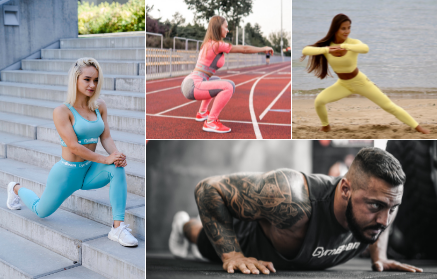
Add a comment